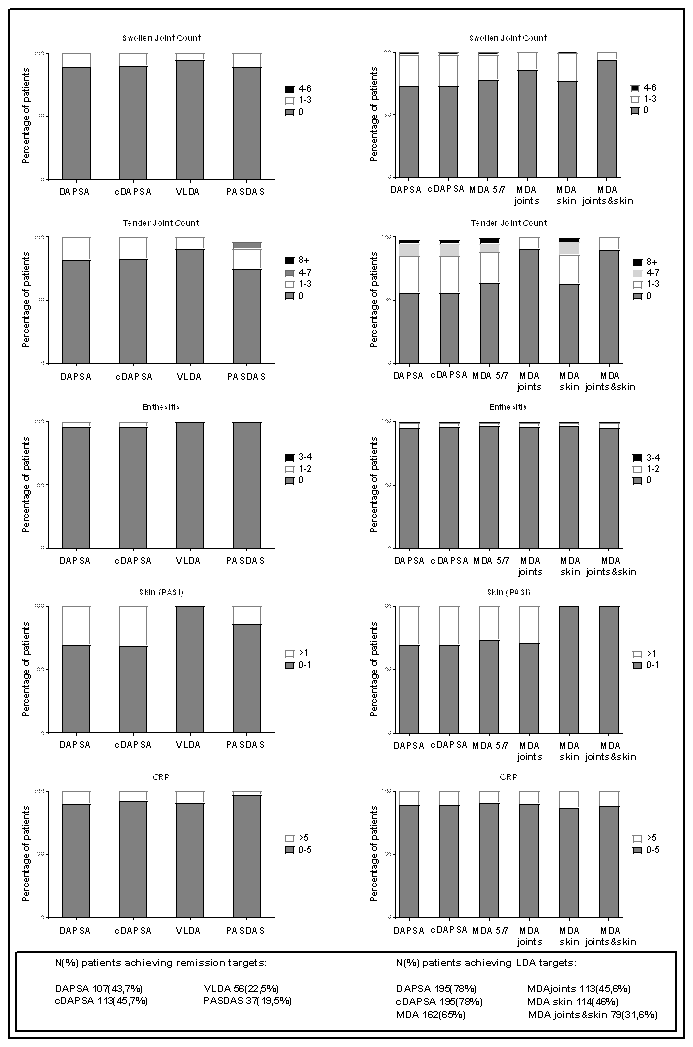Session Information
Session Type: ACR Poster Session C
Session Time: 9:00AM-11:00AM
Background/Purpose: Recommendations on psoriatic arthritis (PsA) state that the target of treatment should be remission or inactive disease with an alternative target of minimal or low disease activity(LDA). Multiple potential targets have been developed, each with a different composition of clinical measurements. Our aim is to use an existing real life dataset of a large group of patients in a low disease activity state, to compare different targets for LDA and provide further evidence to choose a target.
Methods: 250 PsA patients considered in an acceptable disease state according to their rheumatologist were included. Targets for remission were the DAPSA and cDAPSA remission (≤4), VLDA and PASDAS ≤ 1.9 (NR). LDA targets analyzed were the DAPSA LDA ≤14 , clinical cDAPSA≤13, MDA, adjusted MDA targets: MDAjoints with both TJC and SJC cut-offs mandated, MDAskin where PASI was mandated, MDAjoint&skin where the TJC, SJC and PASI cut-offs mandated.
Results: Of the remission targets, DAPSA/cDAPSA and VLDA show the highest agreement (kappa of 0.516 and 0.544 resp.). The agreement between PASDAS NR and DAPSA/cDAPSA/VLDA was lower, (kappa of 0.403, 0.321, 0.319 resp). PASDAS NR was more stringent than DAPSA/cDAPSA remission. All patients who met VLDA were in DAPSA/cDAPSA remission.
Of the LDA targets, the highest agreement is seen between the DAPSA/cDAPSA and the MDA5/7 (kappa of 0,596 and 0,611 respectively). Agreement between the DAPSA and the alternative MDA measures (MDA joints, MDA skin and MDA joints and skin) is lower as these targets are more stringent (0.356, 0.372, 0.227 resp.).
Comparison of the several candidate measures demonstrates that VLDA is achieved by the lowest proportion of patients and includes patients with the lowest residual disease activity compared with the other remission measures. The modified MDA measures are the most stringent targets for low disease activity in terms of residual disease on joints, psoriasis and enthesitis within patients achieving the target. (see graph) In both remission and LDA measures the inclusion of CRP did not show an added value. A PASI>1 was more prevalent in (c)DAPSA in comparison with the 4 MDA measures. Patients with active psoriasis in the DAPSA group report significantly larger impact of skin disease on dermatology related quality of life (DLQI) (DLQI 0-1: 1,25(SD2,4) v.s. DLQI >1: 1,55(2,7).
Conclusion: The different remission and low disease activity targets show that despite significant overlap between the measures, measures targeting the same definition do differ from one another in terms of allowance of residual disease present within the patients. Inclusion of laboratory markers seems unnecessary although exclusion of a skin domain might result in negligence of skin disease in some patients despite a QoL impact.
To cite this abstract in AMA style:
van Mens L, van Kuijk A, Baeten D, Coates LC. the Ideal Target for Psoriatic Arthritis? Comparison of Remission and Low Disease Activity States in a Real Life Cohort [abstract]. Arthritis Rheumatol. 2017; 69 (suppl 10). https://acrabstracts.org/abstract/the-ideal-target-for-psoriatic-arthritis-comparison-of-remission-and-low-disease-activity-states-in-a-real-life-cohort/. Accessed .« Back to 2017 ACR/ARHP Annual Meeting
ACR Meeting Abstracts - https://acrabstracts.org/abstract/the-ideal-target-for-psoriatic-arthritis-comparison-of-remission-and-low-disease-activity-states-in-a-real-life-cohort/

